BBUS1003 Case Study: Barriers in Intercultural Communication
VerifiedAdded on 2022/11/23
|7
|1381
|57
Report
AI Summary
This case study report delves into the intricacies of business communication, focusing on intercultural aspects and their impact on organizational dynamics. The report begins by outlining the three levels of organizational culture: artifacts, espoused values, and basic assumptions, emphasizing their contribution to a company's social and spiritual environment. It then explores the relationship between language and culture, highlighting how language reflects and shapes cultural perspectives, and how both influence each other. The report identifies key barriers to intercultural communication, including language differences, background discrepancies, and prejudices, and stereotypes, and discusses their negative effects on workplace communication and trust. Finally, the report examines the significance of cultural diversity in the workplace, acknowledging both its positive and negative impacts on communication and collaboration, and emphasizing the need for strategic management to harness its benefits effectively.
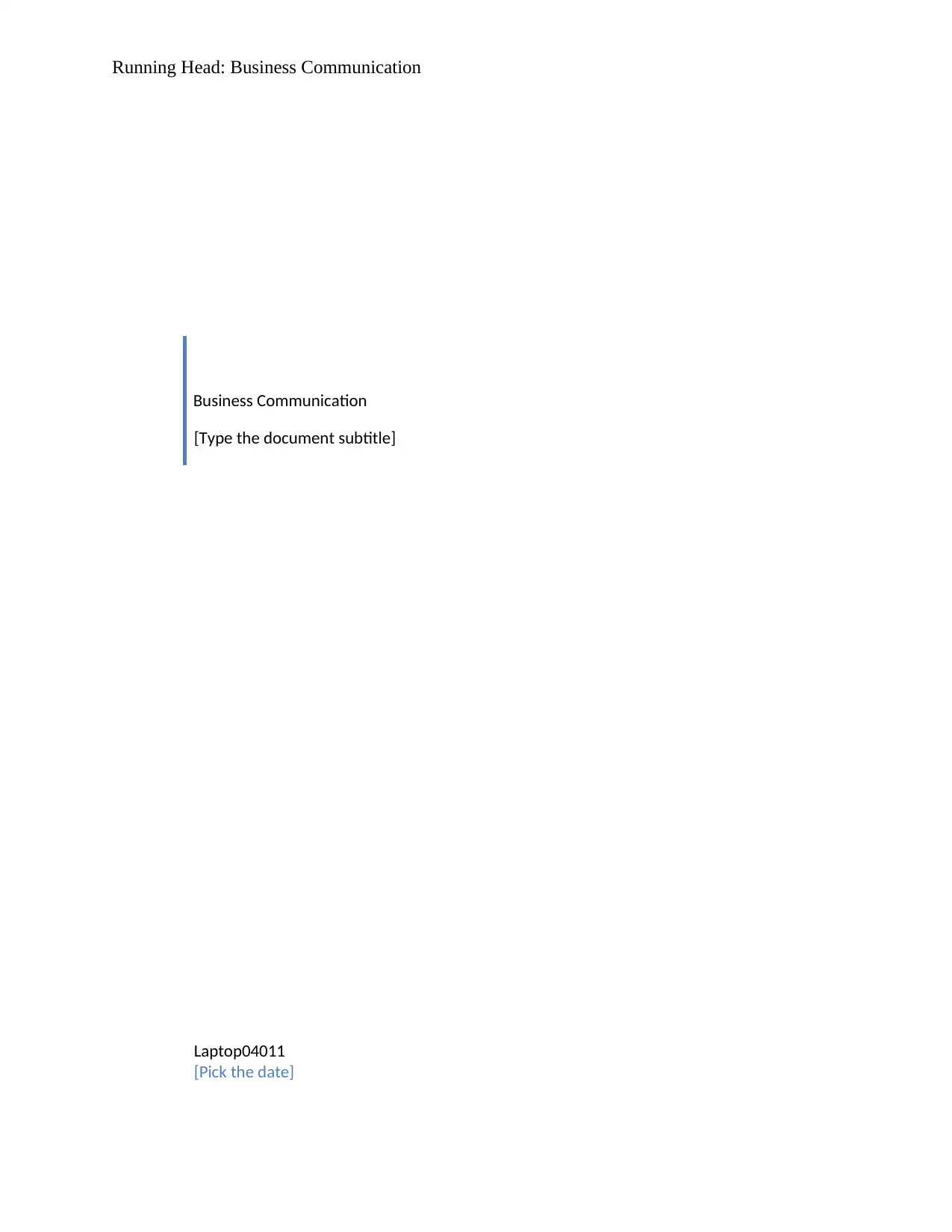
Running Head: Business Communication
Business Communication
[Type the document subtitle]
Laptop04011
[Pick the date]
Business Communication
[Type the document subtitle]
Laptop04011
[Pick the date]
Paraphrase This Document
Need a fresh take? Get an instant paraphrase of this document with our AI Paraphraser
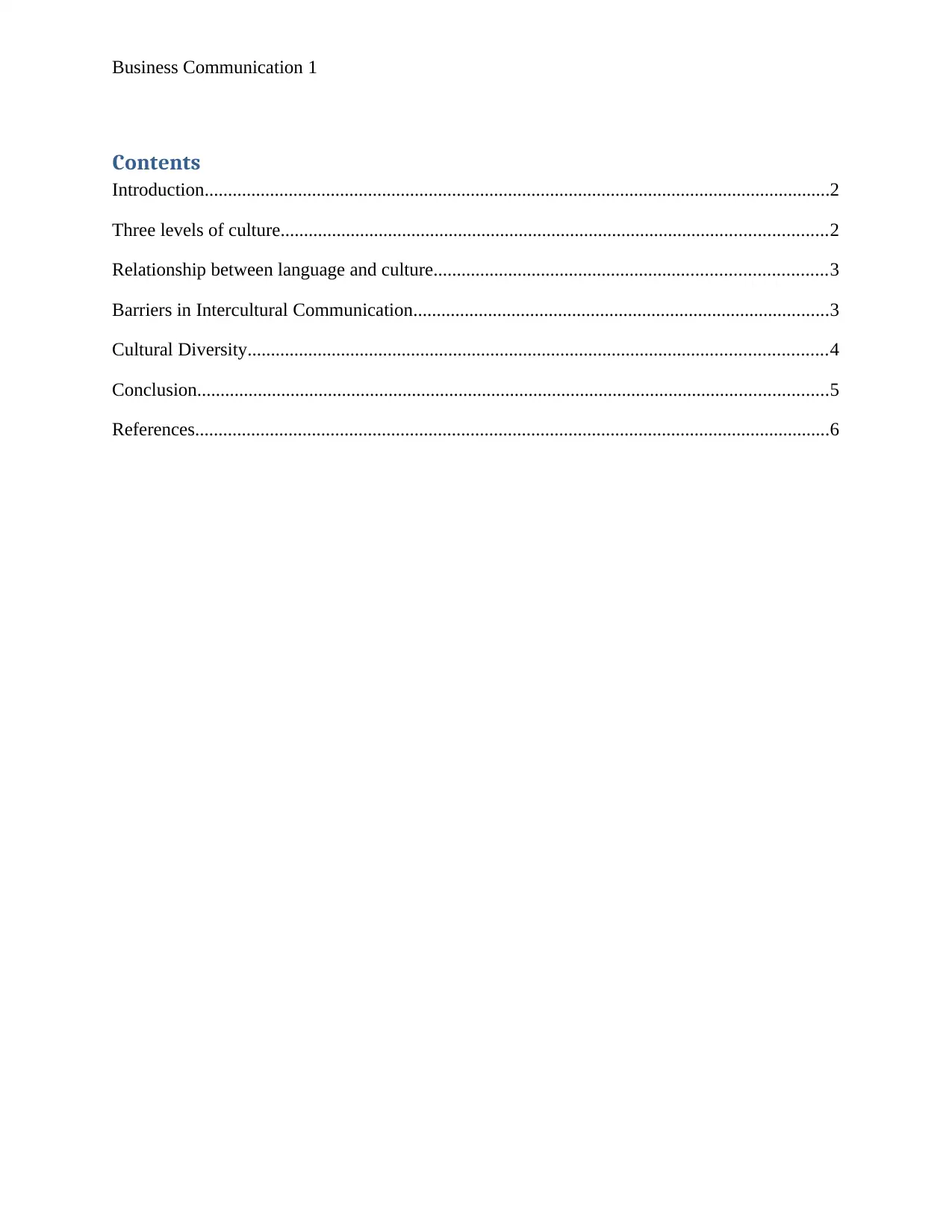
Business Communication 1
Contents
Introduction......................................................................................................................................2
Three levels of culture.....................................................................................................................2
Relationship between language and culture....................................................................................3
Barriers in Intercultural Communication.........................................................................................3
Cultural Diversity............................................................................................................................4
Conclusion.......................................................................................................................................5
References........................................................................................................................................6
Contents
Introduction......................................................................................................................................2
Three levels of culture.....................................................................................................................2
Relationship between language and culture....................................................................................3
Barriers in Intercultural Communication.........................................................................................3
Cultural Diversity............................................................................................................................4
Conclusion.......................................................................................................................................5
References........................................................................................................................................6
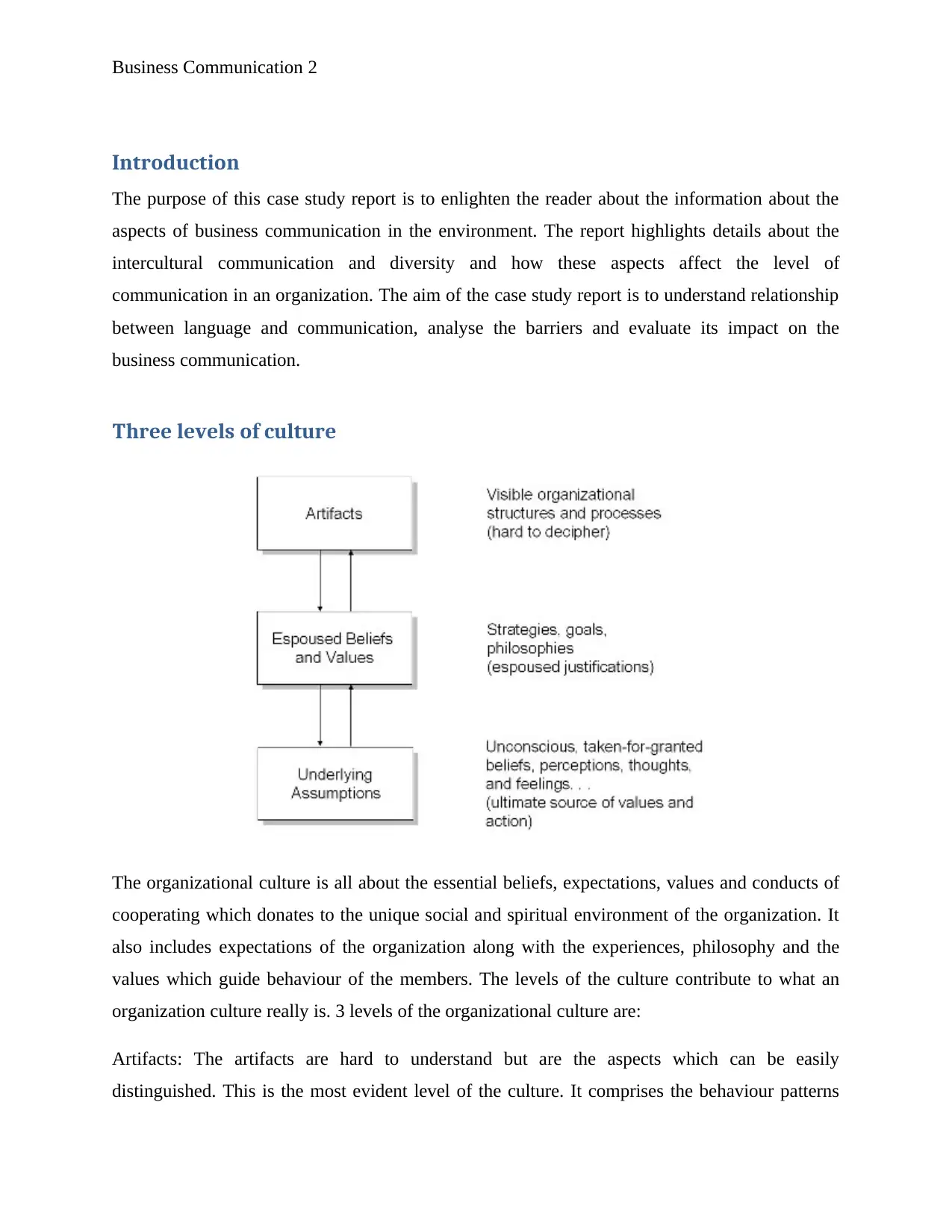
Business Communication 2
Introduction
The purpose of this case study report is to enlighten the reader about the information about the
aspects of business communication in the environment. The report highlights details about the
intercultural communication and diversity and how these aspects affect the level of
communication in an organization. The aim of the case study report is to understand relationship
between language and communication, analyse the barriers and evaluate its impact on the
business communication.
Three levels of culture
The organizational culture is all about the essential beliefs, expectations, values and conducts of
cooperating which donates to the unique social and spiritual environment of the organization. It
also includes expectations of the organization along with the experiences, philosophy and the
values which guide behaviour of the members. The levels of the culture contribute to what an
organization culture really is. 3 levels of the organizational culture are:
Artifacts: The artifacts are hard to understand but are the aspects which can be easily
distinguished. This is the most evident level of the culture. It comprises the behaviour patterns
Introduction
The purpose of this case study report is to enlighten the reader about the information about the
aspects of business communication in the environment. The report highlights details about the
intercultural communication and diversity and how these aspects affect the level of
communication in an organization. The aim of the case study report is to understand relationship
between language and communication, analyse the barriers and evaluate its impact on the
business communication.
Three levels of culture
The organizational culture is all about the essential beliefs, expectations, values and conducts of
cooperating which donates to the unique social and spiritual environment of the organization. It
also includes expectations of the organization along with the experiences, philosophy and the
values which guide behaviour of the members. The levels of the culture contribute to what an
organization culture really is. 3 levels of the organizational culture are:
Artifacts: The artifacts are hard to understand but are the aspects which can be easily
distinguished. This is the most evident level of the culture. It comprises the behaviour patterns
⊘ This is a preview!⊘
Do you want full access?
Subscribe today to unlock all pages.

Trusted by 1+ million students worldwide
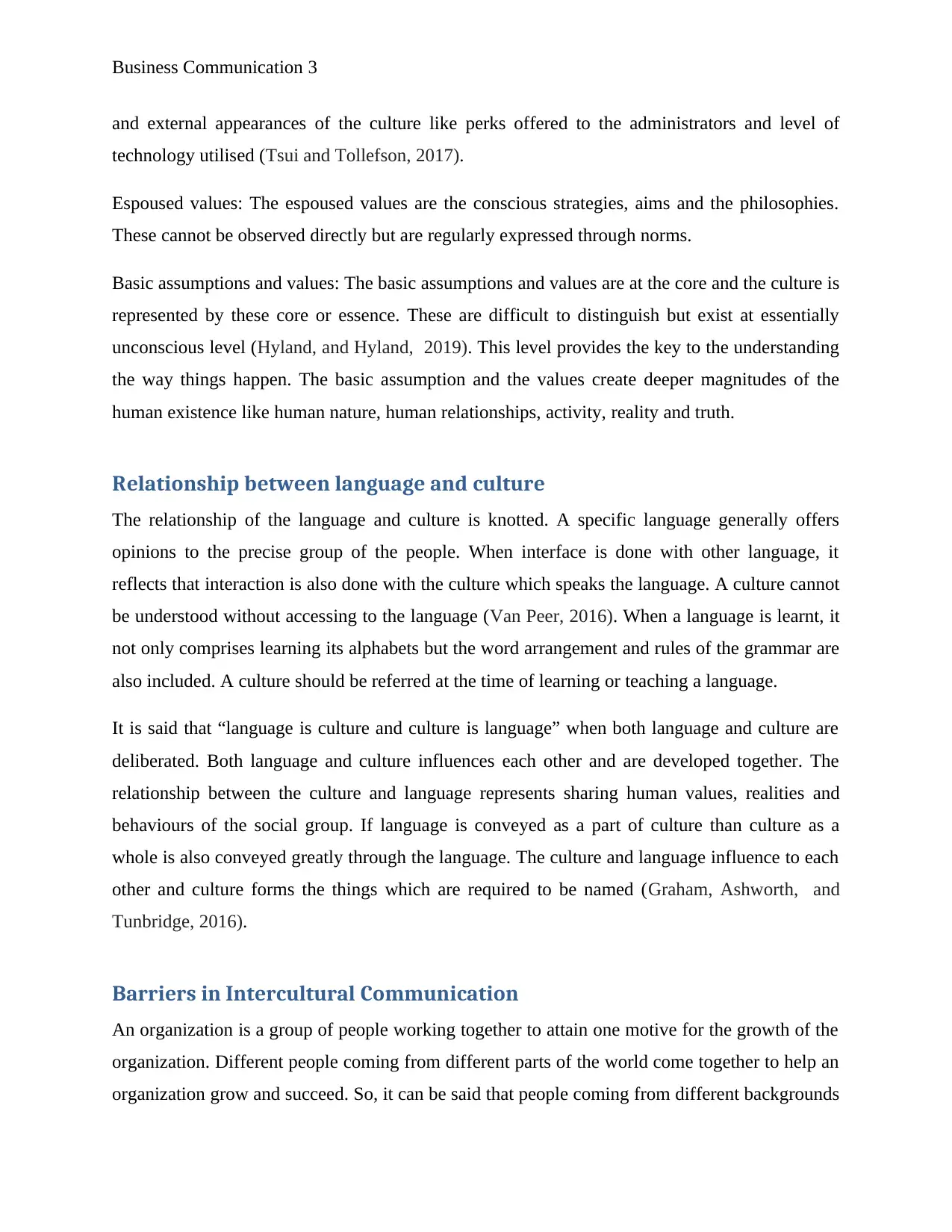
Business Communication 3
and external appearances of the culture like perks offered to the administrators and level of
technology utilised (Tsui and Tollefson, 2017).
Espoused values: The espoused values are the conscious strategies, aims and the philosophies.
These cannot be observed directly but are regularly expressed through norms.
Basic assumptions and values: The basic assumptions and values are at the core and the culture is
represented by these core or essence. These are difficult to distinguish but exist at essentially
unconscious level (Hyland, and Hyland, 2019). This level provides the key to the understanding
the way things happen. The basic assumption and the values create deeper magnitudes of the
human existence like human nature, human relationships, activity, reality and truth.
Relationship between language and culture
The relationship of the language and culture is knotted. A specific language generally offers
opinions to the precise group of the people. When interface is done with other language, it
reflects that interaction is also done with the culture which speaks the language. A culture cannot
be understood without accessing to the language (Van Peer, 2016). When a language is learnt, it
not only comprises learning its alphabets but the word arrangement and rules of the grammar are
also included. A culture should be referred at the time of learning or teaching a language.
It is said that “language is culture and culture is language” when both language and culture are
deliberated. Both language and culture influences each other and are developed together. The
relationship between the culture and language represents sharing human values, realities and
behaviours of the social group. If language is conveyed as a part of culture than culture as a
whole is also conveyed greatly through the language. The culture and language influence to each
other and culture forms the things which are required to be named (Graham, Ashworth, and
Tunbridge, 2016).
Barriers in Intercultural Communication
An organization is a group of people working together to attain one motive for the growth of the
organization. Different people coming from different parts of the world come together to help an
organization grow and succeed. So, it can be said that people coming from different backgrounds
and external appearances of the culture like perks offered to the administrators and level of
technology utilised (Tsui and Tollefson, 2017).
Espoused values: The espoused values are the conscious strategies, aims and the philosophies.
These cannot be observed directly but are regularly expressed through norms.
Basic assumptions and values: The basic assumptions and values are at the core and the culture is
represented by these core or essence. These are difficult to distinguish but exist at essentially
unconscious level (Hyland, and Hyland, 2019). This level provides the key to the understanding
the way things happen. The basic assumption and the values create deeper magnitudes of the
human existence like human nature, human relationships, activity, reality and truth.
Relationship between language and culture
The relationship of the language and culture is knotted. A specific language generally offers
opinions to the precise group of the people. When interface is done with other language, it
reflects that interaction is also done with the culture which speaks the language. A culture cannot
be understood without accessing to the language (Van Peer, 2016). When a language is learnt, it
not only comprises learning its alphabets but the word arrangement and rules of the grammar are
also included. A culture should be referred at the time of learning or teaching a language.
It is said that “language is culture and culture is language” when both language and culture are
deliberated. Both language and culture influences each other and are developed together. The
relationship between the culture and language represents sharing human values, realities and
behaviours of the social group. If language is conveyed as a part of culture than culture as a
whole is also conveyed greatly through the language. The culture and language influence to each
other and culture forms the things which are required to be named (Graham, Ashworth, and
Tunbridge, 2016).
Barriers in Intercultural Communication
An organization is a group of people working together to attain one motive for the growth of the
organization. Different people coming from different parts of the world come together to help an
organization grow and succeed. So, it can be said that people coming from different backgrounds
Paraphrase This Document
Need a fresh take? Get an instant paraphrase of this document with our AI Paraphraser
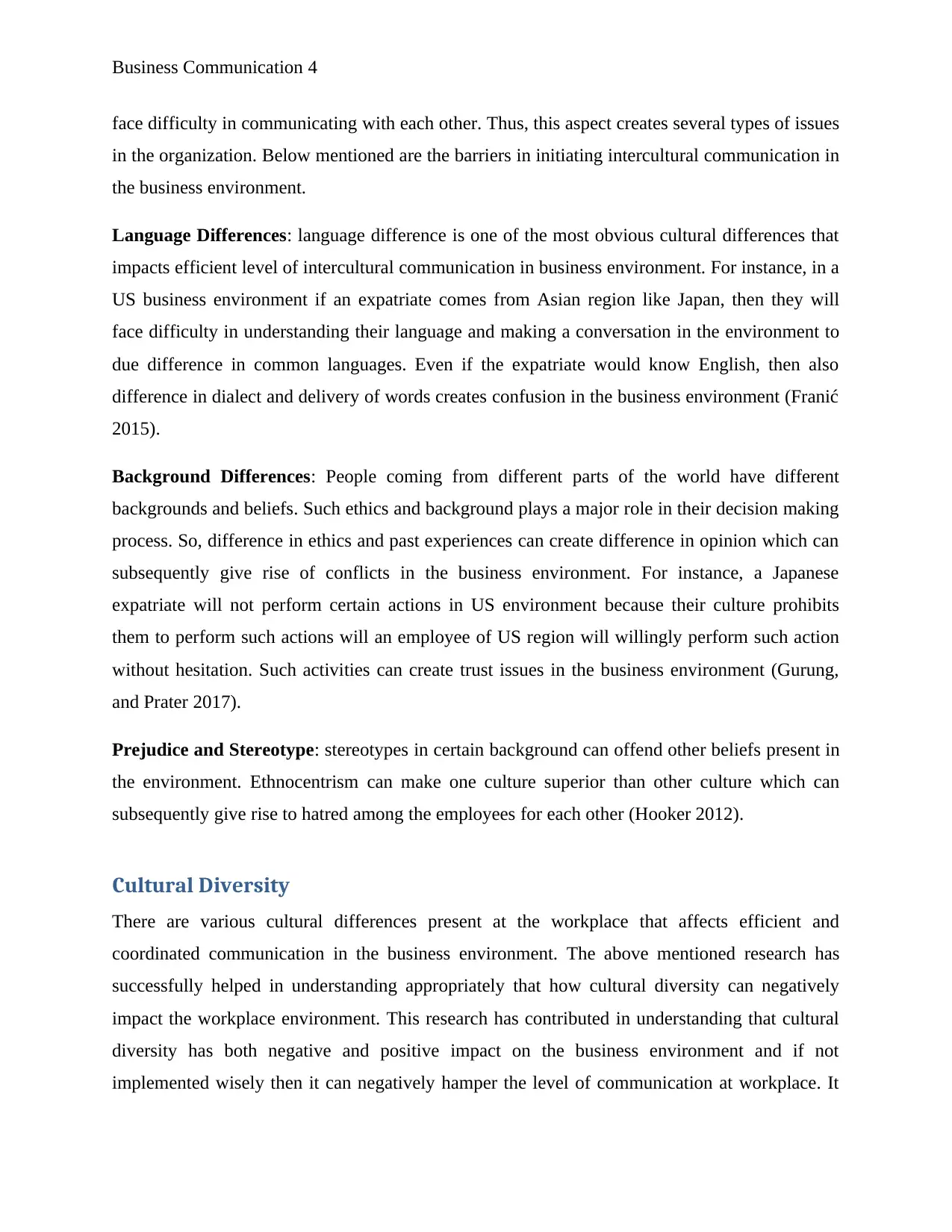
Business Communication 4
face difficulty in communicating with each other. Thus, this aspect creates several types of issues
in the organization. Below mentioned are the barriers in initiating intercultural communication in
the business environment.
Language Differences: language difference is one of the most obvious cultural differences that
impacts efficient level of intercultural communication in business environment. For instance, in a
US business environment if an expatriate comes from Asian region like Japan, then they will
face difficulty in understanding their language and making a conversation in the environment to
due difference in common languages. Even if the expatriate would know English, then also
difference in dialect and delivery of words creates confusion in the business environment (Franić
2015).
Background Differences: People coming from different parts of the world have different
backgrounds and beliefs. Such ethics and background plays a major role in their decision making
process. So, difference in ethics and past experiences can create difference in opinion which can
subsequently give rise of conflicts in the business environment. For instance, a Japanese
expatriate will not perform certain actions in US environment because their culture prohibits
them to perform such actions will an employee of US region will willingly perform such action
without hesitation. Such activities can create trust issues in the business environment (Gurung,
and Prater 2017).
Prejudice and Stereotype: stereotypes in certain background can offend other beliefs present in
the environment. Ethnocentrism can make one culture superior than other culture which can
subsequently give rise to hatred among the employees for each other (Hooker 2012).
Cultural Diversity
There are various cultural differences present at the workplace that affects efficient and
coordinated communication in the business environment. The above mentioned research has
successfully helped in understanding appropriately that how cultural diversity can negatively
impact the workplace environment. This research has contributed in understanding that cultural
diversity has both negative and positive impact on the business environment and if not
implemented wisely then it can negatively hamper the level of communication at workplace. It
face difficulty in communicating with each other. Thus, this aspect creates several types of issues
in the organization. Below mentioned are the barriers in initiating intercultural communication in
the business environment.
Language Differences: language difference is one of the most obvious cultural differences that
impacts efficient level of intercultural communication in business environment. For instance, in a
US business environment if an expatriate comes from Asian region like Japan, then they will
face difficulty in understanding their language and making a conversation in the environment to
due difference in common languages. Even if the expatriate would know English, then also
difference in dialect and delivery of words creates confusion in the business environment (Franić
2015).
Background Differences: People coming from different parts of the world have different
backgrounds and beliefs. Such ethics and background plays a major role in their decision making
process. So, difference in ethics and past experiences can create difference in opinion which can
subsequently give rise of conflicts in the business environment. For instance, a Japanese
expatriate will not perform certain actions in US environment because their culture prohibits
them to perform such actions will an employee of US region will willingly perform such action
without hesitation. Such activities can create trust issues in the business environment (Gurung,
and Prater 2017).
Prejudice and Stereotype: stereotypes in certain background can offend other beliefs present in
the environment. Ethnocentrism can make one culture superior than other culture which can
subsequently give rise to hatred among the employees for each other (Hooker 2012).
Cultural Diversity
There are various cultural differences present at the workplace that affects efficient and
coordinated communication in the business environment. The above mentioned research has
successfully helped in understanding appropriately that how cultural diversity can negatively
impact the workplace environment. This research has contributed in understanding that cultural
diversity has both negative and positive impact on the business environment and if not
implemented wisely then it can negatively hamper the level of communication at workplace. It
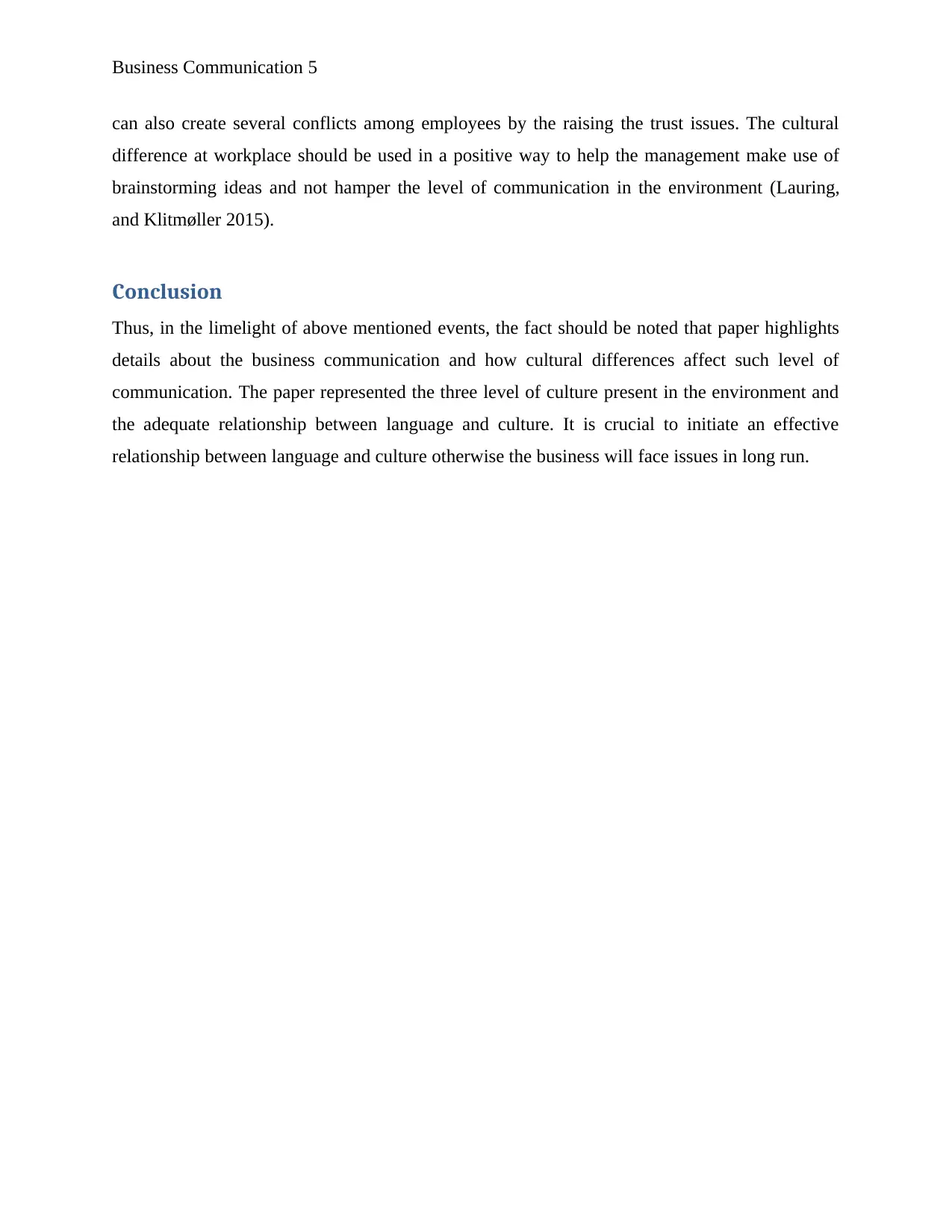
Business Communication 5
can also create several conflicts among employees by the raising the trust issues. The cultural
difference at workplace should be used in a positive way to help the management make use of
brainstorming ideas and not hamper the level of communication in the environment (Lauring,
and Klitmøller 2015).
Conclusion
Thus, in the limelight of above mentioned events, the fact should be noted that paper highlights
details about the business communication and how cultural differences affect such level of
communication. The paper represented the three level of culture present in the environment and
the adequate relationship between language and culture. It is crucial to initiate an effective
relationship between language and culture otherwise the business will face issues in long run.
can also create several conflicts among employees by the raising the trust issues. The cultural
difference at workplace should be used in a positive way to help the management make use of
brainstorming ideas and not hamper the level of communication in the environment (Lauring,
and Klitmøller 2015).
Conclusion
Thus, in the limelight of above mentioned events, the fact should be noted that paper highlights
details about the business communication and how cultural differences affect such level of
communication. The paper represented the three level of culture present in the environment and
the adequate relationship between language and culture. It is crucial to initiate an effective
relationship between language and culture otherwise the business will face issues in long run.
⊘ This is a preview!⊘
Do you want full access?
Subscribe today to unlock all pages.

Trusted by 1+ million students worldwide
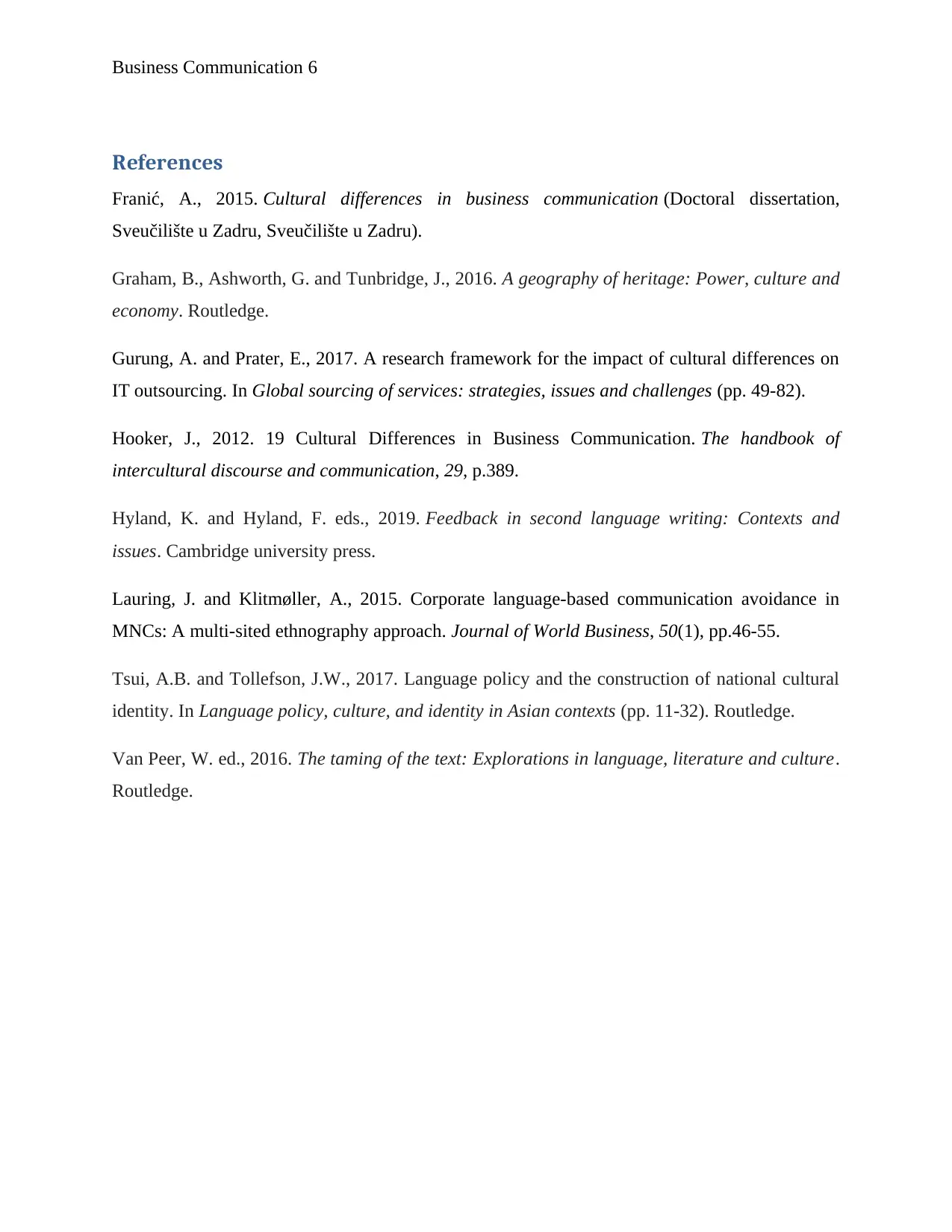
Business Communication 6
References
Franić, A., 2015. Cultural differences in business communication (Doctoral dissertation,
Sveučilište u Zadru, Sveučilište u Zadru).
Graham, B., Ashworth, G. and Tunbridge, J., 2016. A geography of heritage: Power, culture and
economy. Routledge.
Gurung, A. and Prater, E., 2017. A research framework for the impact of cultural differences on
IT outsourcing. In Global sourcing of services: strategies, issues and challenges (pp. 49-82).
Hooker, J., 2012. 19 Cultural Differences in Business Communication. The handbook of
intercultural discourse and communication, 29, p.389.
Hyland, K. and Hyland, F. eds., 2019. Feedback in second language writing: Contexts and
issues. Cambridge university press.
Lauring, J. and Klitmøller, A., 2015. Corporate language-based communication avoidance in
MNCs: A multi-sited ethnography approach. Journal of World Business, 50(1), pp.46-55.
Tsui, A.B. and Tollefson, J.W., 2017. Language policy and the construction of national cultural
identity. In Language policy, culture, and identity in Asian contexts (pp. 11-32). Routledge.
Van Peer, W. ed., 2016. The taming of the text: Explorations in language, literature and culture.
Routledge.
References
Franić, A., 2015. Cultural differences in business communication (Doctoral dissertation,
Sveučilište u Zadru, Sveučilište u Zadru).
Graham, B., Ashworth, G. and Tunbridge, J., 2016. A geography of heritage: Power, culture and
economy. Routledge.
Gurung, A. and Prater, E., 2017. A research framework for the impact of cultural differences on
IT outsourcing. In Global sourcing of services: strategies, issues and challenges (pp. 49-82).
Hooker, J., 2012. 19 Cultural Differences in Business Communication. The handbook of
intercultural discourse and communication, 29, p.389.
Hyland, K. and Hyland, F. eds., 2019. Feedback in second language writing: Contexts and
issues. Cambridge university press.
Lauring, J. and Klitmøller, A., 2015. Corporate language-based communication avoidance in
MNCs: A multi-sited ethnography approach. Journal of World Business, 50(1), pp.46-55.
Tsui, A.B. and Tollefson, J.W., 2017. Language policy and the construction of national cultural
identity. In Language policy, culture, and identity in Asian contexts (pp. 11-32). Routledge.
Van Peer, W. ed., 2016. The taming of the text: Explorations in language, literature and culture.
Routledge.
1 out of 7
Related Documents
Your All-in-One AI-Powered Toolkit for Academic Success.
+13062052269
info@desklib.com
Available 24*7 on WhatsApp / Email
![[object Object]](/_next/static/media/star-bottom.7253800d.svg)
Unlock your academic potential
Copyright © 2020–2025 A2Z Services. All Rights Reserved. Developed and managed by ZUCOL.





